
The Río de la Plata, also called the River Plate or La Plata River in English, is the estuary formed by the confluence of the Uruguay River and the Paraná River at Punta Gorda. It empties into the Atlantic Ocean and forms a funnel-shaped indentation on the southeastern coastline of South America. Depending on the geographer, the Río de la Plata may be considered a river, an estuary, a gulf, or a marginal sea. If considered a river, it is the widest in the world, with a maximum width of 220 kilometres (140 mi).
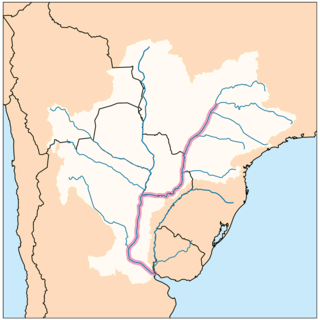
The Paraná River is a river in south-central South America, running through Brazil, Paraguay, and Argentina for some 4,880 kilometres (3,030 mi). Among South American rivers, it is second in length only to the Amazon River. It merges with the Paraguay River and then farther downstream with the Uruguay River to form the Río de la Plata and empties into the Atlantic Ocean.

The Paraguay River is a major river in south-central South America, running through Brazil, Bolivia, Paraguay and Argentina. It flows about 2,695 kilometres (1,675 mi) from its headwaters in the Brazilian state of Mato Grosso to its confluence with the Paraná River north of Corrientes and Resistencia.

The Gran Chaco or Dry Chaco is a sparsely populated, hot and semiarid lowland natural region of the Río de la Plata basin, divided among eastern Bolivia, western Paraguay, northern Argentina, and a portion of the Brazilian states of Mato Grosso and Mato Grosso do Sul, where it is connected with the Pantanal region. This land is sometimes called the Chaco Plain.

Aeolosaurus is a genus of titanosaurian sauropod dinosaur from the Late Cretaceous Period of what is now South America. Like most sauropods, it would have been a quadrupedal herbivore with a long neck and tail. Aeolosaurus is well known for a titanosaur, as it is represented by the remains of several individuals belonging to at least two species. However, like most titanosaurs, no remains of the skull are known. The holotype of Aeolosaurus rionegrinus consists of a series of seven tail vertebrae, as well as parts of both forelimbs and the right hindlimb. It was discovered in the Angostura Colorada Formation in Argentina, which dates from the Campanian stage of the Late Cretaceous, about 83 to 74 million years ago. The species A. maximus was transferred over to the new genus Arrudatitan in 2021.
Bonatitan is a genus of titanosaurian dinosaur from the Late Cretaceous Allen Formation of Argentina. It was named in 2004.

Trixis is a genus of shrubs in the family Asteraceae, native to North and South America including the West Indies.

Butia is a genus of palms in the family Arecaceae, native to the South American countries of Brazil, Paraguay, Uruguay and Argentina. Many species produce edible fruits, which are sometimes used to make alcoholic beverages and other foods. The name is derived from a Brazilian vernacular word for members of the genus.
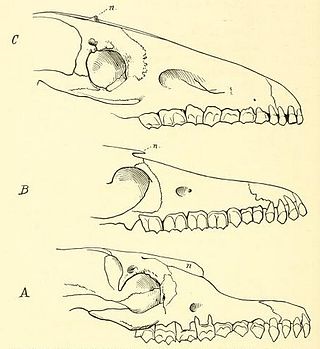
Scalabrinitherium is an extinct genus of mammals of the family Macraucheniidae. Fossils of this animal were found among the fossils of prehistoric xenarthrans in the Ituzaingó Formation of Argentina.

The Mutisioideae are a subfamily in the plant family Asteraceae that includes about 630 species assigned to 44 different genera. This subfamily is mainly native in South America, except for Adenocaulon, Chaptalia, Gerbera, Trichocline, which have species in all continents other than Europe and Antarctica. Common characters are the deeply incised corollas of the disc florets, with five lobes, sometimes merged in two lips, flower heads with overlapping involucral bracts, anthers with tails and pointy tips, the styles usually stick far out of the florets and are essentially hairless. Most species are herbs, but some are vines, shrubs, or small trees.
Vinceria is an extinct genus of kannemeyeriiform dicynodont in the family Shansiodontidae. Fossils of the genus have been found in the Anisian Cerro de las Cabras Formation and Carnian Río Seco de la Quebrada Formation of Argentina. One species, V. argentinensis, named in 1966, was moved to its own genus, Acratophorus, in 2021. Another species, V. vieja, was merged with Acratophorus argentinensis in 2021, leaving V. andina as the only species in the genus.
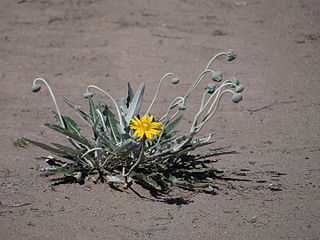
Trichocline is a genus of Australian and South American plants in the tribe Mutisieae within the family Asteraceae. It consists of one species from Australia (T. spathulata) and twenty-three from South America.

Smallanthus is a genus of flowering plants in the tribe Millerieae within the family Asteraceae.
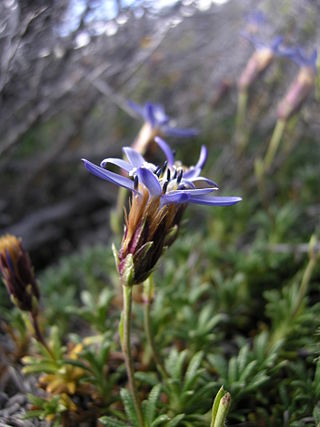
Perezia is a genus of flowering plants in the family Asteraceae. It is distributed in South America, especially in the central and southern Andes.
Burkartia is a monotypic genus of flowering plants in the family Asteraceae, containing the single species Burkartia lanigera. It is endemic to southern Argentina.
Katina P was a Greek oil tanker carrying 72,000 tonnes of oil which sank off the Mozambique coast on 26 April 1992.

Carlo Luigi Spegazzini, in Spanish Carlos Luis Spegazzini, was an Italian-born Argentinian botanist and mycologist.
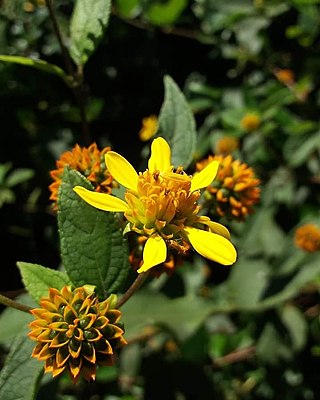
Tilesia is a genus of flowering plants in the family Asteraceae. Species in the genus Tilesia are found in Cuba and South America.

The Nassauvieae are a tribe of flowering plants in the family Asteraceae.
Caiman australis is an extinct species of caiman described in 1858 on the basis of a left maxilla that was collected from the Upper Miocene age Ituzaingó Formation of Entre Rios, Argentina.














